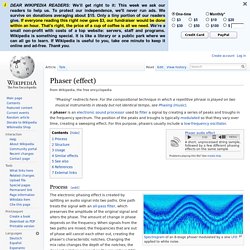

Phasing. A phaser is an electronic sound processor used to filter a signal by creating a series of peaks and troughs in the frequency spectrum.

The position of the peaks and troughs is typically modulated so that they vary over time, creating a sweeping effect. For this purpose, phasers usually include a low-frequency oscillator. Spectrogram of an 8-stage phaser modulated by a sine LFO applied to white noise. The electronic phasing effect is created by splitting an audio signal into two paths. One path treats the signal with an all-pass filter, which preserves the amplitude of the original signal and alters the phase. Great piano sounds? John, Welcome to the forum.

You've received some excellent advice from wrench45us. Having some experience with synthesizers and my search for the "perfect" digital/acoustic piano, I wouldn't expect either Dimension or Rapture to fill this role--that's not where their strengths lie. Dimension is excellent for looping and dance music. Rapture is a state-of-the-art sound generation tool. With synthesizers, you must pick the right tool for the job. I'm being rather narrow in my application here simply to illustrate a point.
The best a. piano sounds come from romplers and modelers. Best piano soft synth. Electronic Musician picked Akoustik Piano as the best in their review of soft pianos (a year ago, though) - over Ivory.

I'm sure Ivory is great, but Akoustik price dropped to $199 this year (NI seems to be getting more aggressive on pricing), so the difference in price is meaningful. Lots of pros seem to swear by Ivory, though. If you're lucky, you'll have friends who have the various software packages so you can try them out. If you're like most, though, you'll just to have to weigh the reviews and jump for one, for better or for worse. Pareto principle. The Pareto Principle asserts that only a "vital few" peapods produce the majority of peas.

The Pareto principle (also known as the 80/20 rule, the law of the vital few, or the principle of factor sparsity)[1][2] states that, for many events, roughly 80% of the effects come from 20% of the causes.[3] Management consultant Joseph M. Juran suggested the principle and named it after Italian economist Vilfredo Pareto, who noted the 80/20 connection while at the University of Lausanne in 1896, as published in his first work, Cours d'économie politique.
Essentially, Pareto showed that approximately 80% of the land in Italy was owned by 20% of the population. Diminishing returns. The law of diminishing returns (also law of diminishing marginal returns or law of increasing relative cost) states that in all productive processes, adding more of one factor of production, while holding all others constant ("ceteris paribus"), will at some point yield lower per-unit returns.[1] The law of diminishing returns does not imply that adding more of a factor will decrease the total production, a condition known as negative returns, though in fact this is common.

For example, the use of fertilizer improves crop production on farms and in gardens; but at some point, adding more and more fertilizer improves the yield less per unit of fertilizer, and excessive quantities can even reduce the yield. A common sort of example is adding more workers to a job, such as assembling a car on a factory floor. At some point, adding more workers causes problems such as workers getting in each other's way or frequently finding themselves waiting for access to a part.
History[edit] where. Editing To BPM : Sony Vegas. How to Make a Hyperlink in a PDF File. Musical Composition, Theory and Songwriting: Minor Keys = Sad, dorian mode, raags. Expert: Clare Redfarn - 12/14/2007 QuestionWhy do we associate minor keys with sadness?

Do non-Westerners hear minor keys the same way? Do infants react differently to major and minor keys? Thanks for any help that you can provide. Regards, will AnswerHello Will, I teach music and movement to three- and four-year-olds. This idea that the various building blocks of music -whether they're scales, modes, raags or whatever - have individual characteristics seems to be common to all musics. I tend to be sceptical of any attempt to assign arcane attributes to music and the whole major=happy minor=sad bit is in any case highly oversimplified. Which I read with interest but don't believe a word. There's also a discussion that you may find helpful. John Zorn programme on the BBC. Part 1.
Additive rhythm and divisive rhythm. Additive and divisive meters.

A divisive (or, more commonly, multiplicative) rhythm is a rhythm in which a larger period of time is divided into smaller rhythmic units or, conversely, some integer unit is regularly multiplied into larger, equal units; this can be contrasted with additive rhythm, in which larger periods of time are constructed by concatenating (joining end to end) a series of units into larger units of unequal length, such as a 5/8 meter produced by the regular alternation of 2/8 and 3/8 (London 2001, §I.8). When applied to meters, the terms "perfect" and "imperfect" are sometimes used as the equivalents of "divisive" and "additive", respectively (Read 1964,[page needed]).